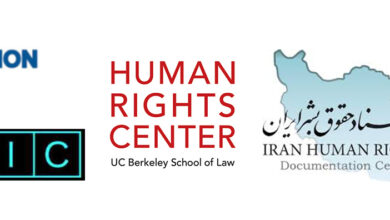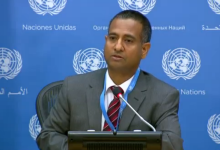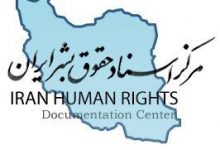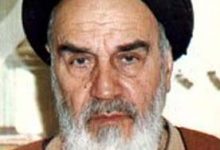Aadel Collection
Attacks on the press 1999: Iran
Attacks on the Press 1999: Iran- Conntdttee to Protect Journalists http://cpj org/2000/03/attacks-on-tlc-press- 1999-iranphp
C Committee to ProtectJournalists
Defending Journal is: s Worldwide
Attacks on the Press 1999: Iran
The Iranian press was again the main battleground in a bitter power struggle between reformist president Muhammad
Khatami and Iran's conservative clerical establishment, led by Ayatollah Ali Khamenei, supreme leader of the Islamic
Republic. With crucial parliamentary elections slated for February 2000, the conservatk ,e-controlled judiciary pressed
ahead with a steady campaign of repression against reformist newspapers and journalists in an attempt to stifle support
for the president's agenda of political and social liberalization. The year was marked by a wave of newspaper
suspensions and closures along with the arrest and prosecution of journalists under various vaguely worded statutes
governing the press.
Since President Khatami took office in August 1997, after promising greater press freedom, the Iranian press has
flourished. Dozens of new publications have been licensed, with many tackling controversial social and political topics
that would have been unthinkable in previous years. In the absence of legal opposition parties, the press has increasingly
functioned as a platform for political debate among opposing factions within the Islamic regime.
As the judiciary flexed its muscle against reformist papers and journalists throughout the year, the press found itself at
the center of dramatic political events. On July 6, the Iranian Parliament approved a harsh draft press law granting
authorities enhanced powers to punish dissenting journalists. On July 7, the Special Court for Clergy closed down the
popular pro-Khatami daily Salam, triggering student demonstrations of a magnitude not seen since the 1979 revolution.
The closure followed the paper's publication of an alleged secret memo by a former intelligence agent, urging authorities
to tighten restrictions on the press.
Other prominent publications were similarly targeted. In September, a court shut down the daily Neshat--the most recent
incarnation in a series of pro-Khatami titles with the same management that judicial authorities have closed successively
over the past two years--because of two articles it published criticizing capital punishment in Iran. The paper's director,
Latif Safari, was later convicted of “insulting the sanctity and tenets of Islam” and given a suspended sentence of 30
months in prison. A few months later, Nestiat editor Mashallah Shamsolvaezin was convicted of forgery and offending
Islam in connection with the articles and sentenced to three years in prison.
Although reformist papers received the lion's share of harassment, a number of conservative papers also suffered
adverse judicial attention. In July, for example, the Ministry of Culture and Islamic Guidance (controlled by allies of
President Khatami) filed suit against the conservative papers Kayhan, Javan, and Jumtiuri-e-Islami over their
publication of a letter from Revolutionary Guards commanders to President Khatami, criticizing the president's handling
of the student unrest in July.
Authorities deployed an array of statutes to prosecute outspoken journalists. The press law, for example, proscribes the
publication of information deemed “harmful to Islamic principles” and the publication of “false information,” giving courts
wide berth to punish dissident journalists. Offenses are punishable by stiff prison sentences and fines.
1 of 6 03/08 2010 14:29
Attacks on the Press 1999: Iran- Contnittee to Protect Journalists http://cpj ,org/2000/03/attacks-on-tle-press- 1 999-iran.php
The controversial draft press bill that Parliament approved in July would, if passed, expand official powers to sanction
the press. The draft bill gives conservatives a greater say on the influential Press Supervisory Board, which has the
power to close newspapers and send journalists to court. It also empowers exceptional revolutionary courts to try
journalists and requires journalists to reveal their sources if taken to court.
The judiciary's steady clampdown on the press climaxed with the high-profile trial of former interior minister and vice
president and Khatami ally Abdullah Noun, who was charged by the Special Court for Clergy with religious dissent for
articles published in his daily newspaper, Khordad. He was subsequently convicted and sentenced to five years in prison.
During the trial, Noun transfixed the nation with a poignant self-defense in which he sharply criticized the clerical
establishment and called for greater freedoms in Iranian society.
While print media grew increasingly bold, television and radio remained under the firm control of the conservative
establishment. With their limited circulation throughout the country, newspapers were at a great disadvantage in
competing with broadcast media's ability to reach wide audiences. However, satellite television offered an important
alternative source of news and information for many Iranians. Despite an existing government ban on satellite dishes,
they were widely available, and authorities appeared unwilling or unable to take active measures to enforce the ban.
Nonetheless, there was concern in May when Ayatollah Khamenei declared his opposition to eliminating the government
ban and urged tougher measures against the use of dishes. Press reports quoted him as saying that authorities “should
identify ways to prevent .. satellite transmissions [ that are] proportional with the advance of technology.”
January 23
Zan CENSORED
Faezah Hashemi, Zan LEGAL ACTION
A Teheran court imposed a two-week suspension on the reformist women's daily Zan for allegedly defaming police
intelligence chief Gen. Muhammad Naghdi.
Naghdi filed a complaint after the newspaper implicated him in a physical attack on former vice president Abdullah Noun
and Culture Minister Ataollah Mohajerani outside Tehran University in September 1998. The court also fined Zan's
publisher, Faezah Hashemi, about 1,500,000 rials (US$500).
January 25
Khordad ATTACKED, THREATENED
Two unidentified men on motorbikes hurled a percussion grenade at the Tehran office of the reformist daily Khordad.
The grenade shattered windows and slightly wounded two people. After the incident, the paper's staff received an
anonymous phone call threatening further attacks.
February 27
Mohsen Kadivar, Khordad IMPRISONED
On April 21, Kadivar, a reformist cleric and academic, was sentenced to 18 months in prison by Iran's Special Court for
Clergy for “disseminating lies” and “misleading public opinion.” The charges stemmed from articles, interviews, and public
2 of6 03/08 2010 14:29
Attacks on tile Press 1999: Iran - Committee to Protect Journalists http://cpj .org/2000/03/attacks-on-the-press- 1 999-iraiLphp
lectures in which he criticized the Islamic Republic. In one article, published in the now defunct daily Khordad on
February 14, Kadivar attacked Irans ruling clerics, comparing their authoritarian rule to that of the shah.
Kadivars conviction was upheld on appeal in July. He has been in jail since February 27, when he was first arrested.
April 6
Zan CENSORED
An Islamic revolutionary court banned the reformist daily Zan after it published a New Years message from Farah Diba,
wife of the late Shah Mohammad Reza Pahlavi, along with a satirical cartoon about the practice of making murderers
pay so-called blood money. The cartoon depicts a man begging an armed criminal to spare him and kill his wife instead,
since less blood money is demanded for a womans life than for a mans.
Hojatoleslam Gholamhossein Rahbarpour, head of the revolutionary court, was quoted as saying that “publishing a
caricature in which blood money, one of the main judicial and religious principles of Islam, is ridiculed [ must be viewed as
a] direct insult.” Rahbarpour added that the publication of Dibas message was a “blatant anti-revolutionary act.”
For his part, Iranian judiciary head Ayatollah Muhammad Yazdi referred to Faezah Hashemi, Zans publisher, a member
of Parliament and the daughter of former president Akbar Hashemi Rafsanjani, as a “counter-revolutionary,” adding,
“Thats why the revolutionary court is in charge of her case.”
June 16
Heshmatollah Tarbarzadi, Hove yat-e-Khish IMPRISONEDHussein Kashani, Hove yat-e-Khish IMPRISONED
Hove yat-e-Khish CENSORED
Tarbarzadi, a student leader and the editor of the biweekly student newspaper Hoveyat-e-Khish, and Kashani, the
papers director, were detained on or about June 16 by order of an Iranian revolutionary court. The two journalists were
accused of “issuing an anti-establishment communiqu ” and “spreading propaganda against the Islamic system,”
according to Iranian officials. Authorities did not release further details.
Hove yat-e-Khish was also ordered suspended; the paper remained closed at years end.
Kashani was released later that month and Tarbarzadi five months later, on November 4. It is unclear whether formal
charges were ever brought against either journalist.
July 7
Salam CENSORED
Mohamed Musavi-Khoeiniha, Salam LEGAL ACTION
The Special Court for Clergy ordered the indefinite closure of the reformist daily Salam, one day after it published an
alleged secret memo written by a former intelligence agent.
In the putative memo, Said Emami (also known as Said Eslami) advised his superiors to crack down on the Iranian
press. In June, Emami died in prison, reportedly a suicide. He had been jailed in connection with the assassinations of
3 of6 03/08 2010 14:29
Attacks on tile Press 1999: Iran - Committee to Protect Journalists http://cpj .org/2000/03/attacks-on-the-press- 1 999-iraiLphp
several dissidents and writers in late 1998.
The closure of Salam, coupled with Parliaments preliminary approval of a restrictive press bill on July 6, triggered a
wave of student protests and riots unparalleled since the Islamic revolution of 1979.
On July 25, the Special Court for Clergy convicted Salams publisher, Musavi-Khoeiniha, of defamation and spreading
false information in connection with the alleged memo. He was sentenced to three years in prison and a lashing.
However, the court suspended this sentence and instead ordered Musavi-Khoeiniha to pay a fine of 23 million rials
(US$13,000).
On August 4, the Special Court for Clergy imposed a five-year ban on Salam and banned Musavi-Khoeiniha from
practicing journalism for three years. The court ruled that the journalist was “guilty of disseminating untruthful and
distorted news aimed at harming public opinion.”
CPJ protested the crackdown on Salam and other independent media in a July 28 letter to supreme Iranian leader
Ayatollah Ali Khamenei.
July 20
Kazem Shukri, Sobh-e-Emrouz IMPRISONED
Shukri, an editor for the reformist daily Sobh-e-Emrouz, was arrested by order of Irans Press Court for allegedly
insulting Islamic principles. The charge stemmed from a July 8 article entitled “Two Parallel Lines Do Not Cross Unless
God Wills So.”
Shukri was freed on August 11 on US$50,000 bail and awaits trial. CPJ protested the incident in a July 28 letter to
Iranian supreme leader Ayatollah Ali Khamenei.
July 28
Camelia Entekhabi-Fard, Zan IMPRISONED
On or about July 28, authorities arrested Entekhabi-Fard, a journalist who formerly worked for the now defunct womens
newspaper Zan. She was arrested soon after returning from a six-month visit to the United States and Europe.
According to Iranian press reports, the journalist was accused of “cooperation with American media.”
During her trip, Entekhabi-Fard interned with Radio Free Europe/Radio Liberty (RFE/RL), which broadcasts in Persian to
Iran, and attended a journalism training program sponsored by RFE/RL in Prague.
Entekhabi-Fard was released in early October. At years end, it was unclear whether there were still charges pending
against her.
September 5
Neshat CENSORED
Irans Press Court ordered the closure of the popular reformist daily Neshat for insulting the sacred decrees of Islam
4 of6 03/08 2010 14:29
Attacks on tile Press 1999: Iran - Committee to Protect Journalists http://cpj .org/2000/03/attacks-on-the-press- 1 999-iraiLphp
and the supreme leader,” the latter a reference to Ayatollah Ali Khamenei, supreme leader of the Islamic Republic.
The closure followed the publication of two items in previous issues of Neshat. The first was an article that questioned
the use of capital punishment in Islam. The second item was a letter from an opposition figure who challenged the
authority of Ayatollah Khamenei and urged him to distance himself from hard-liners in the Iranian regime.
CPJ condemned the closure of Neshat in a September 21 letter to Ayatollah Mahmud Shahrudi, head of the Iranian
judiciary.
September 20
Latif Safari, Neshat LEGAL ACTION, CENSORED
Irans Press Court convicted Safari, director of the reformist daily Neshat, on several charges including “insulting the
sanctity and tenets of Islam.” The main charge probably came in response to Neshats publication of an opinion piece
challenging the use of capital punishment in Iran. The article is believed to have triggered the September 5 closure of the
newspaper by order of the Press Court.
Safari was also reportedly convicted of inciting unrest and defaming officials. The former charge apparently arose from
Neshafs coverage of student riots that shook the country in July. On September 25, Safari was given a suspended
sentence of 30 months in prison and was banned from working as a journalist for five years. The court also closed
Neshat.
CPJ condemned Safaris conviction and Neshafs closure in a September 21 letter to Ayatollah Mahmud Shahrudi, head
of the Iranian judiciary.
October11
Jaleh Oskoui, Panjshanbeha IMPRISONED, LEGAL ACTION
Panjshanbeha CENSORED
Oskoui, managing editor of the weekly Panjshanbeha, was arrested by order of the Press Court for publishing allegedly
false and “unethical” material.
The charges stemmed in part from the papers coverage of a controversial play that had been published in a student
newsletter. Authorities deemed the play blasphemous. They were apparently also unhappy about a story quoting a
government official on the closure of a number of acting schools.
Panjshanbeha was suspended pending the conclusion of all legal proceedings against Oskoui. The journalist was
released on bail on or about October 18. Her trial in Irans Press Court began on November 15.
November 27
Abdullah Noun, Khordad IMPRISONED, LEGAL ACTION
Khordad CENSORED
In a trial that gripped the nation, Irans Special Court for Clergy tried and convicted Noun, publisher of the reformist daily
5 of6 03/08 2010 14:29
Attacks on the Press 1999: Iran- Conntdttee to Protect Journalists http://cpj org/2000/03/attacks-on-tlc-press- 1999-iranphp
Khordad and a former interior minister, of religious dissent.
The charges, which included defaming “the system,” disseminating false information and propaganda against the state,
and insulting religious leaders, were based on news articles published in Khordad.
Noun was sentenced to five years in prison and barred from practicing journalism for fke years. Khordad was ordered to
close. Noun was subsequently jailed at Tehran's Evin Prison. In a Nowmber 30 letter to Iranian supreme leader
Ayatollah Ali Khamenei, CPJ called for Noun's immediate release and urged authorities to lift the ban on Khordad.
Noun's appeal was pending at year's end.
November 27
Mashallah Shamsolvaezin, Neshat, Asr-e-Azadegan IMPRISONED, LEGAL ACTION
A Tehran court convicted Shamsolvaezin, editor of the reformist daily Asr-e-Azadegan, of insulting Islam and committing
forgery.
The case against Shamsolvaezin was based on two articles published in the now defunct newspaper Neshat, which he
edited until judicial authorities closed the paper in September, that criticized capital punishment in Iran. One article was
written by Hossein Baqerzadeh, an Iranian human-rights acthAst and writer based in the United Kingdom. The court
accused Shamsolvaezin of forging Baqerzadeh's article, despite the fact that Baqerzadeh has publicly acknowledged
writing the piece.
On November 2, Shamsolvaezin was arrested in connection with the case and held for 15 days until he posted bail of
US$166,000 on November 17. Shamsolvaezin was sentenced to three years in prison and ordered to pay a fine of 12
million rials. His appeal was pending at year's end; meanwhile he remained free on bail.
In a November 30 letter to Iranian supreme leader Ayatollah Ali Khamenei, CPJ condemned Shamsolvaezin's conviction.
March 22, 2000 12:05 PM ET I Permalink (hftp://cpj.orq/2000/03/attacks-on-the-press-1999-iran.php )
6 of 6 03/08 2010 14:29







